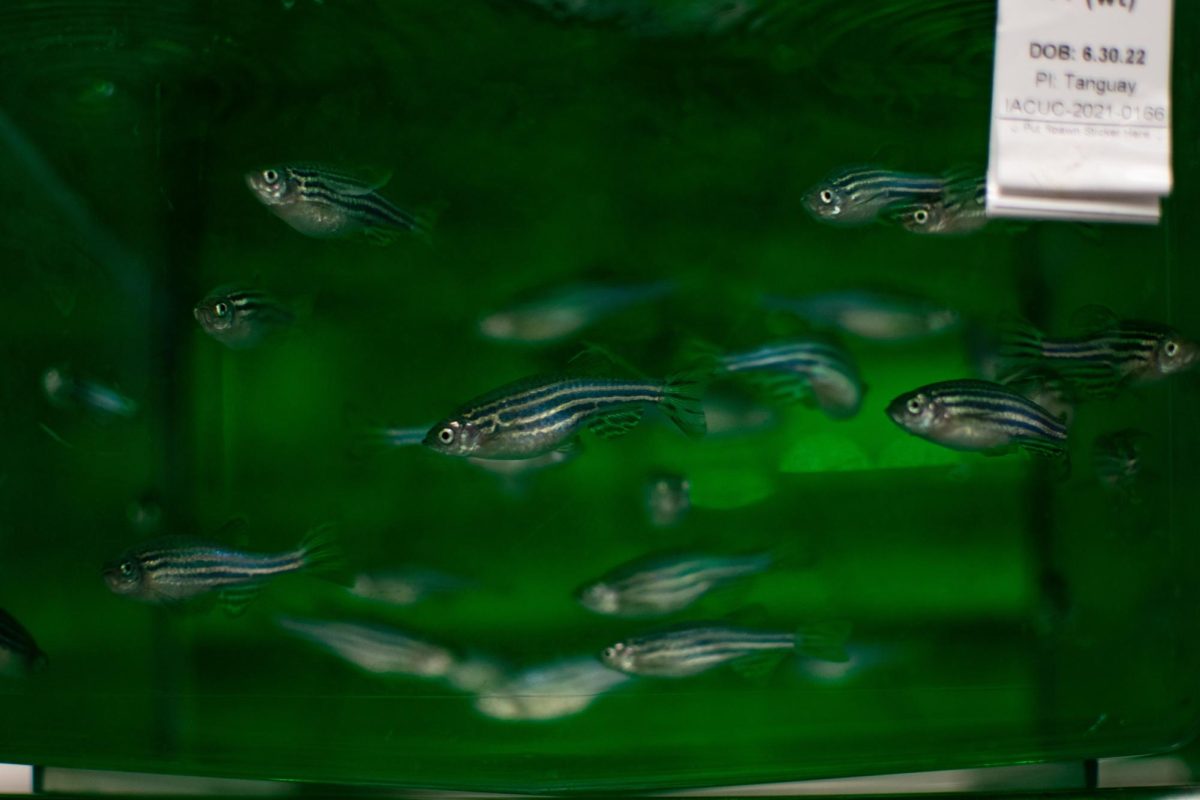A school of paperclip-sized, striped fish dart around the bubbling tank.
Wiggling in the currents, dropping between the surface and bottom, it’s surprising to think these zebrafish are one of the most widely-used models for humans in research labs.
For the past 20 years, Robyn Tanguay and her research team have used tanks upon tanks of zebrafish just like these to study molecular toxicology in the Sinnhuber Aquatic Research Laboratory, located two miles from the main Oregon State University campus in a standalone building.
This year, the lab received a $7.5 million grant from the National Institute of Health to upgrade.
“We use the zebrafish model to essentially screen chemicals for their ability to help fish in order to protect human health. We do things like screen drugs for safety. We screened environmental chemicals to see if they’re safe or not. We help companies pick safer alternative chemicals to perform functions that their chemicals need to perform,” Tanguay said.
Mice, flies and even brewer’s yeast are other popular model organisms used for similar scientific research. According to Tanguay, the way human embryos develop and the way that zebrafish embryos develop are almost exactly the same; the genes necessary to accomplish those processes are nearly the same. Zebrafish are a model system that has all the complexity of human biology, with the advantages of fast growth, easy care and reproducible results that cannot be found in larger animals.
It’s using this model that Tanguay and her team have risen to international prominence.
“We’re already, I think, the third largest zebrafish lab in academia in the world,” Michael Simonich, the high throughput screening director for the lab said. “but (with these upgrades) it’s definitely going to be the largest zebrafish facility in North America, for sure.”
Their international prominence isn’t just for their research, with the lab shipping fish to destinations worldwide.
“We send fish to different places around the world; we send to Saudi Arabia, we send to Australia,” Tanguay said. “And then we have folks at many, many companies and universities in the U.S. that we send either embryos or adult fish.”
They also create custom diets and work with a number of companies developing new technology.
“It’s not your grandma’s type of research lab,” Tanguay said.
Besides their research and exporting, the lab hosts tours, especially for school groups in the Corvallis, Albany and Salem areas.
“We love having school groups coming in to do tours. This (new) facility will just make it so much more, not only fun to show off, but it’s just going to be physically bigger so we can have bigger groups come through,” Simonich said.
But the prominence Tanguay, Simonich and the other researchers have achieved has been hard-fought, and the current conditions of the infrastructure haven’t always helped.
“We are the largest zebrafish toxicology facility in the world, by a lot and everyone respects us for that,” Tanguay said. “But I don’t think they really know how hard it was to build.”
The upgrades planned for the lab include an entirely new husbandry building,
“That allows us to raise the adult zebrafish in a very modern way and very efficient way,” Tanguay said.
The building that hosts the lab now has been largely unrenovated since the 1960s.
“You feel like a hamster in a hole trying to work your way through the building and, and clearly we recognize the inefficiencies of that,” Tanguay said.
The modernization efforts that go with these upgrades will include robots on tracks to feed the fish automatically, as well as the implementation of AI and machine learning.
“We have thousands of tanks and everyone has to be fed two or three times a day, every single day,” Tanguay explained. “It seems easy until you have to schedule for holidays, right? Who has to work? Who has to do Thanksgiving, who does Fourth of July, right? So (with) all of these types of automation, you can do (things) much easier.”
Up to thousands of fish must be screened for specific symptoms caused by the toxic environments, a technique involved in high throughput screening which can be repetitive and time-consuming.
“High throughput screening involves a lot of mundane, repetitive stuff day in, day out, that isn’t all that much fun for people to do. So we’d rather have people working on experimental designs, and data interpretation and data analysis and drafting reports for publication,” Simonich said.
The $7.5 million grant, the first of its kind in OSU history, came on behalf of the NIH Research and Infrastructure Office.
“They try to recognize applicants that have a lot of, I guess, cool NIH-related research going and they want us to tell them, ‘Hey, if we could invest more money into your infrastructure, what more could you do? Or how could you do it even better?’” Tanguay said.
Both Tanguay and Simonich see the grant as an investment in the research they have already done.
“Over the years the laboratory has worked because we’ve produced so much good data and high profile studies. Our ability to secure grant funding has increased and we knew that we could at least entertain you know, having a bigger vision for a zebrafish facility,” Simonich said.
“They recognized us as a strength and they’re investing in us to maintain this strength for at least 20 years,” Tanguay said.
Plans for the construction are still being finalized, but Simonich estimates two years until the upgrades are finished.
“This laboratory is unlike any other laboratory on campus,” Simonich said. “Almost all the staff that are here have been here for a long time. Finally, we get to do this. This big build out, really makes it shine as a facility on the world stage.”

















































































































